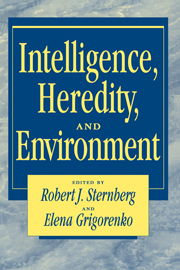Book contents
- Frontmatter
- Contents
- List of contributors
- Preface
- Part I The nature–nurture question: New advances in behavior-genetic research on intelligence
- 1 Behavior-Genetic and Socialization theories of intelligence: Truce and reconciliation
- 2 The puzzle of nongenetic variance
- 3 Identifying genes for cognitive abilities and disabilities
- 4 Heredity, environment, and IQ in the Texas Adoption Project
- 5 IQ similarity in twins reared apart: Findings and responses to critics
- Part II Novel theoretical perspectives on the genes and culture controversy
- Part III Specific issues in the nature–nurture controversy
- Part IV Integration and conclusions
- Name index
- Subject index
2 - The puzzle of nongenetic variance
Published online by Cambridge University Press: 05 June 2012
- Frontmatter
- Contents
- List of contributors
- Preface
- Part I The nature–nurture question: New advances in behavior-genetic research on intelligence
- 1 Behavior-Genetic and Socialization theories of intelligence: Truce and reconciliation
- 2 The puzzle of nongenetic variance
- 3 Identifying genes for cognitive abilities and disabilities
- 4 Heredity, environment, and IQ in the Texas Adoption Project
- 5 IQ similarity in twins reared apart: Findings and responses to critics
- Part II Novel theoretical perspectives on the genes and culture controversy
- Part III Specific issues in the nature–nurture controversy
- Part IV Integration and conclusions
- Name index
- Subject index
Summary
Within the past decade, empirical findings in behavior genetics have importantly changed how researchers in this field think heredity and environment affect individual differences in mental ability. These insights are hardly new. Some are even found in the writings of Sir Francis Galton (1822–1911), the father of behavior genetics. But the recognition, formalization, and empirical support given to them by behavior geneticists in recent years can be considered significant advances. The most surprising findings, only conjectured by Galton, concern the role of environment in the development of mental ability. The present picture is quite different from the beliefs generally held only a decade ago.
Genotype–environment covariance
One such idea is that the perceptible environment is like a cafeteria. People make different selections according to their genetic makeup, or genotype. The environment is not a “given” but is largely the person's own creation. This becomes increasingly true as persons develop from infancy to maturity.
Behavioral differences between persons that result from their self-selected and self-fashioned environments are the phenotypic expression of genotype–environment covariance. It accounts for more of the total variance (i.e., individual differences) in abilities and achievements than was formerly thought. Genotype–environment (GE) covariance is neither a strictly genetic nor a strictly environmental component of phenotypic variance but reflects the genetically driven differential selection of experiences from the available environment. It also includes the effects of differential treatment by parents, teachers, and peers, because their responses are largely evoked by the person's distinctive genotypic characteristics.
- Type
- Chapter
- Information
- Intelligence, Heredity and Environment , pp. 42 - 88Publisher: Cambridge University PressPrint publication year: 1996
- 8
- Cited by

